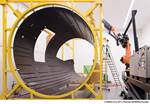ABCs of ultrasonic inspection
A primer on nondestructive ultrasonic inspection technology.
Conventional (non-laser induced) ultrasound (UT) is generated by an element (transducer) made of a piezoelectric material that converts an electrical pulse into a mechanical vibration, which, in turn, induces ultrasonic waves in a test specimen. Any time there is a change in acoustic impedance — such as occurs with a delamination or void — some of the acoustic energy is reflected. The waves that are reflected back to the transducer are converted into a raw electrical signal, measuring amplitude vs. time (think of a seismogram).
For phased-array systems, the probe is composed of multiple elements, which can independently transmit and receive. Time delays are applied to different elements of the probe to focus, steer and scan the beam across the surface. “In the medical field, you can get most of the transmitted ultrasonic energy into our bodies because we are mostly water, but because there is little change in impedance, signal post-processing is often necessary to obtain high-resolution images,” says Deborah Hopkins, BERCLI Corp. (Berkeley, Calif.). “With composites, the issue is strong attenuation caused by inhomogeneity and anisotropy of the material, so you lose energy as a function of distance traveled.” Hopkins says most phased-array ultrasonic applications operate in the range of 2 to 15 MHz.
Related Content
-
CityAirbus NextGen to be developed for future medical missions in Norway
Airbus and the Norwegian Air Ambulance Foundation partner to measure the added value of eVTOL aircraft for medical use cases across Norway.
-
AMSL Aero partners with CareFlight for Vertiia aeromedical fit-out
Together, AMSL Aero’s long-range eVTOL aircraft will enable CareFlight to provide direct services from remote sites directly to hospitals.
-
Evonik showcases chopped carbon fiber-reinforced PEEK filament
Vestakeep is available at two levels of carbon fiber content and appropriate for long-term surgical implants.







.jpg;maxWidth=300;quality=90)



